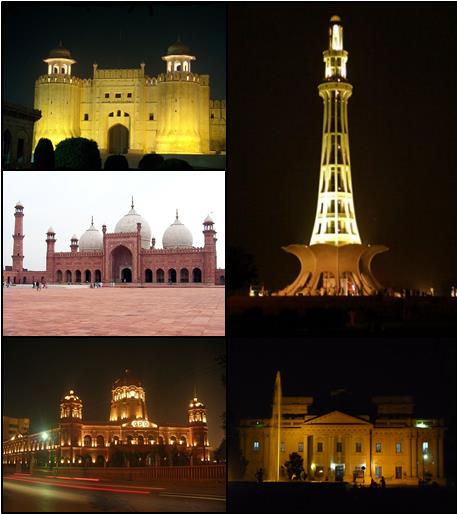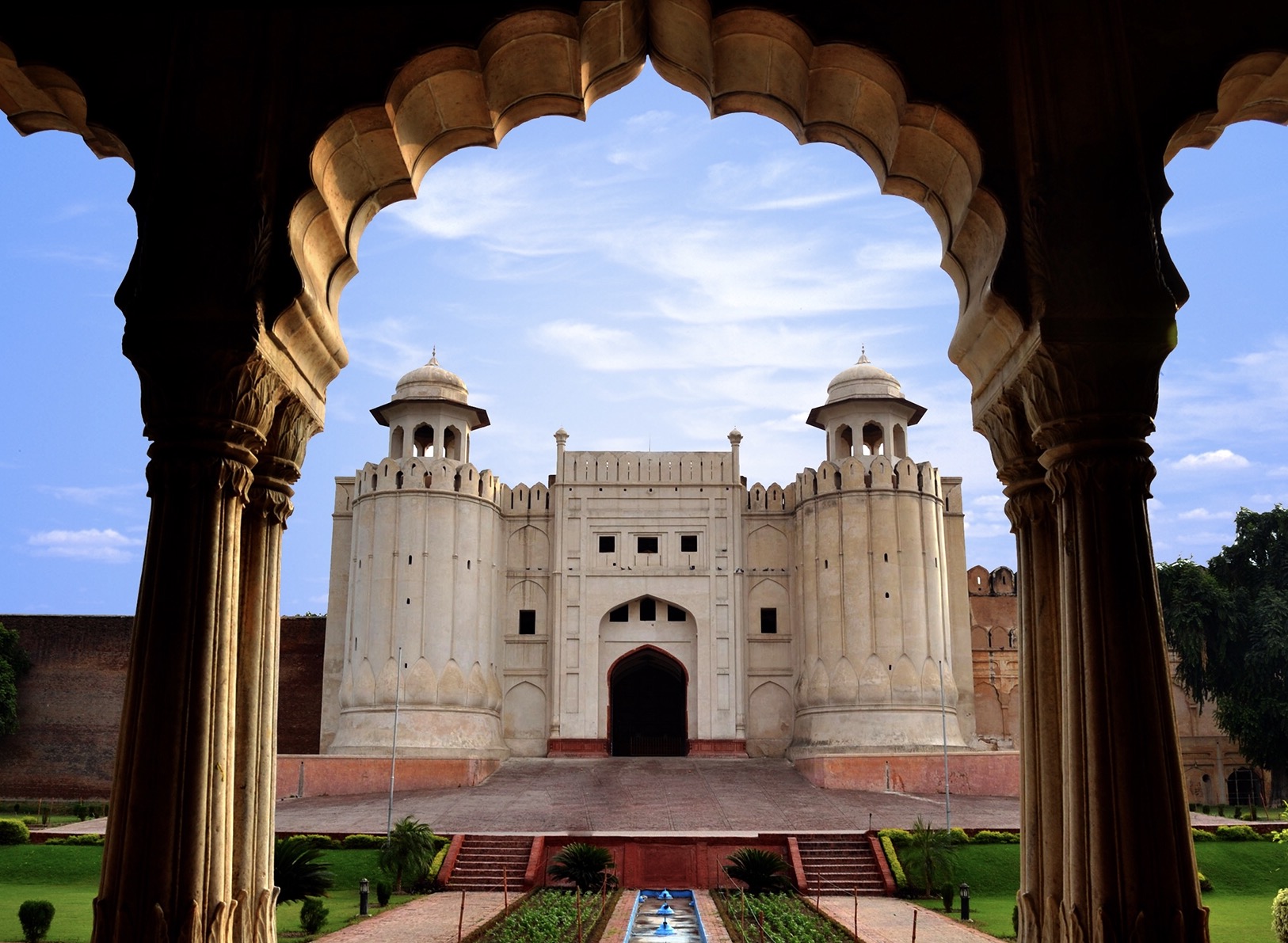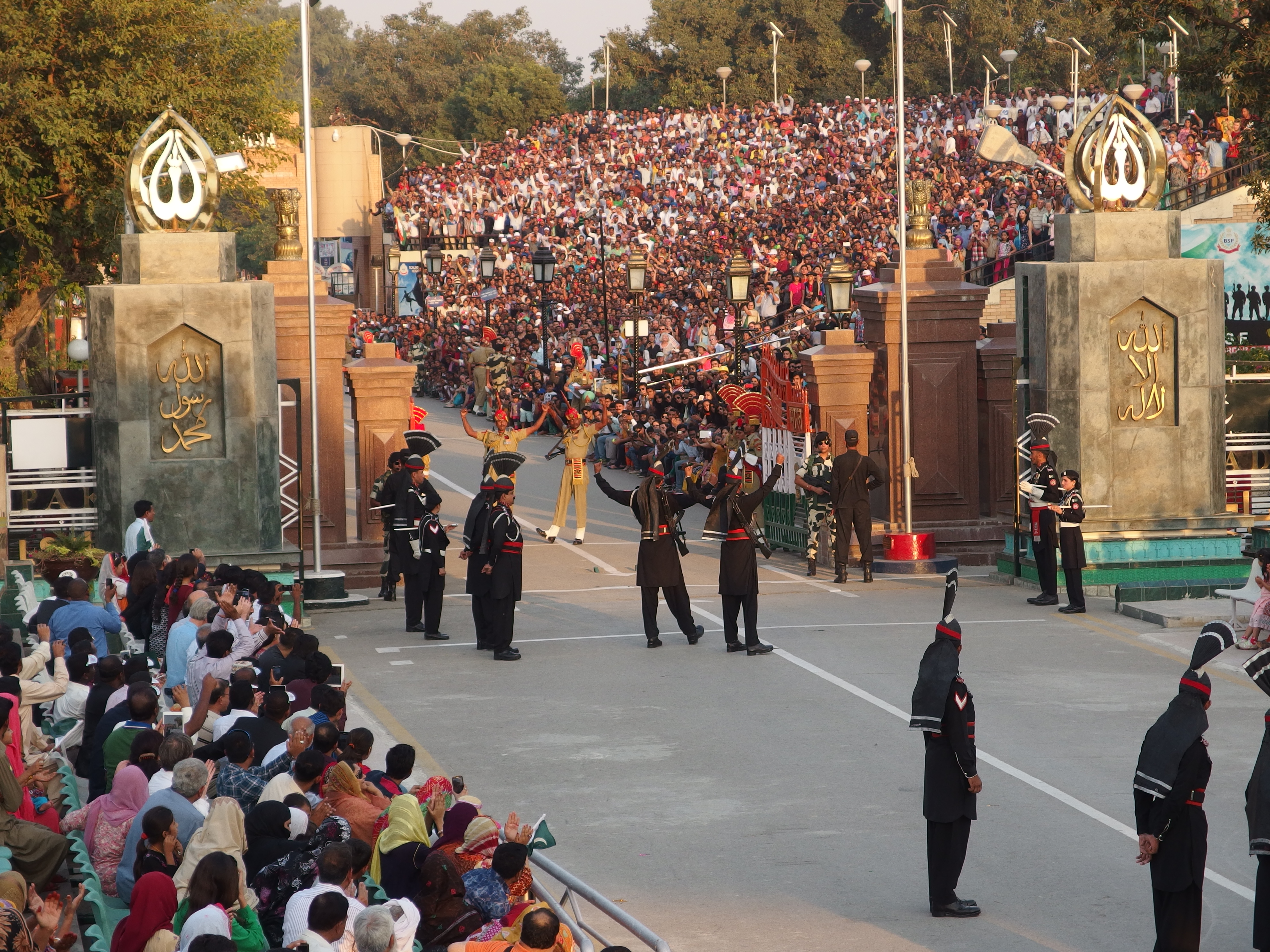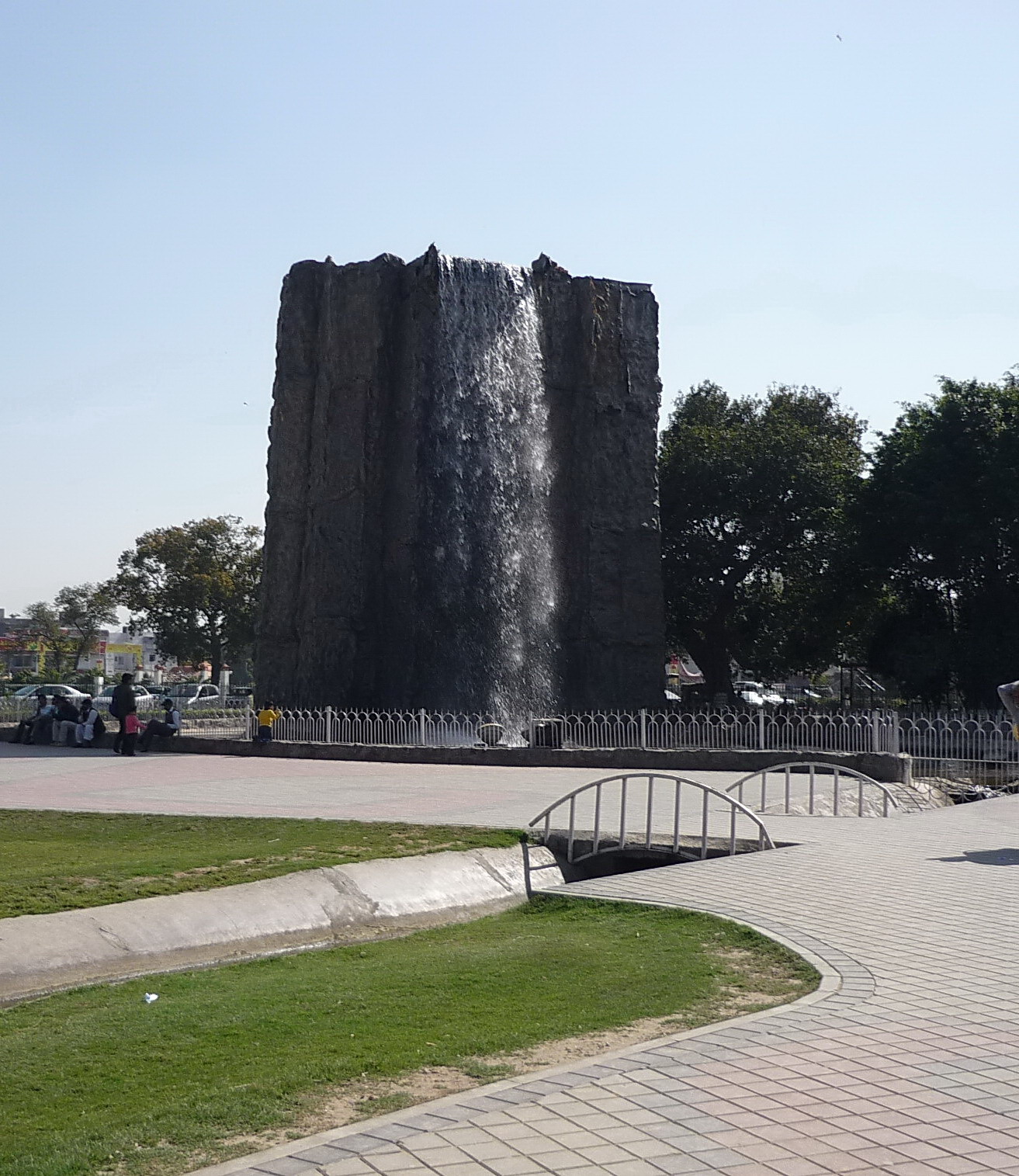Travel To Lahore
This Webpage uses material from the Wikipedia category Category:Lahore, which is released under the Creative Commons Attribution-Share-Alike License 3.0.
Travel to Lahore لاہور

Historically, it is believed to be about 2000 years old. In ancient times, it was an outpost of Kangra hill Kingdoms and was a cut-off township on the trade route to Delhi and It had hardly any reputation in the Pre-Muslim era. Lahore came to eminence with Islam in South Asia.
To find out more, you may refer to following links:
Lahore(Wikipedia)
Lahore(Punjab Portal)
Travel to Lahore لاہور 
Welcome to the City of Gardens, where the People are really Vivacious(زندہ دل)!

Lahore is a must visit place for all. Let me introduce it breifly to you!
Breif Introduction
Lahore is the capital city of the Pakistani province of Punjab, the second largest metropolitan area in the country and 16th most populous city in the world, also known as the Gardens of the Mughals or City of Gardens, after the significant rich heritage of the Mughal Empire. In most popular culture Lahore is known as the Heart of Pakistan. It is located near the river Ravi and the Indian border, Wagah.. It is an important historical center in South Asia. With a rich history dating back over a millennium, Lahore is a main cultural centre of the Punjab region and Pakistan and is the largest Punjabi city in the world. One of the most densely populated cities in the world, Lahore remains an economic, political, transportation, entertainment, and educational hub of Pakistan.Historically, it is believed to be about 2000 years old. In ancient times, it was an outpost of Kangra hill Kingdoms and was a cut-off township on the trade route to Delhi and It had hardly any reputation in the Pre-Muslim era. Lahore came to eminence with Islam in South Asia.
Some Must Visit Places
Here's a list(and description) of some exciting places in Lahore, you must go there and have fun-
Badshahi Masjid(Mosque)
One of the wonders of the Mughals, The Badshahi Mosque in Lahore was commissioned by the sixth Mughal Emperor Aurangzeb. Constructed between 1671 and 1673, it was the largest mosque in the world upon construction. Today it is the second largest mosque in Pakistan and the fifth largest mosque in the world. It is Lahore's most iconic and famous landmark and a major tourist attraction.
-
Minar-e-Pakistan
 A symbol of Pakistan Movement, Minar-e-Pakistan (مینارِ پاکستان , literally "Tower of Pakistan") is a public monument located in Greater Iqbal Park(Formerly Iqbal Park, Minto Park) which is one of the largest urban parks in Lahore, Punjab, Pakistan. The tower was constructed during the 1960s on the site where, on 23 March 1940, the All-India Muslim League passed the Lahore Resolution, the first official call for a separate homeland for the Muslims living in South Asia, in accordance with the two nation theory.
A symbol of Pakistan Movement, Minar-e-Pakistan (مینارِ پاکستان , literally "Tower of Pakistan") is a public monument located in Greater Iqbal Park(Formerly Iqbal Park, Minto Park) which is one of the largest urban parks in Lahore, Punjab, Pakistan. The tower was constructed during the 1960s on the site where, on 23 March 1940, the All-India Muslim League passed the Lahore Resolution, the first official call for a separate homeland for the Muslims living in South Asia, in accordance with the two nation theory.
-
Quaid-e-Azam Library
 If you are Enthuastic to study then you must visit Quaud-e-Azam Library to get benefit from huge stock of knowlege. Located in Bagh-e-Jinnah, a park previously known as "Lawrence Gardens", in Lahore, Pakistan. The library is named after Quaid-e-Azam Muhammad Ali Jinnah, the founder of Pakistan. The Quaid-e-Azam Library has a collection of more than 100,000 volumes, in many languages.
If you are Enthuastic to study then you must visit Quaud-e-Azam Library to get benefit from huge stock of knowlege. Located in Bagh-e-Jinnah, a park previously known as "Lawrence Gardens", in Lahore, Pakistan. The library is named after Quaid-e-Azam Muhammad Ali Jinnah, the founder of Pakistan. The Quaid-e-Azam Library has a collection of more than 100,000 volumes, in many languages.
-
Shalimar Gardens
 One of the historical gardens of Lahore, The Shalimar Gardens or Shalamar Gardens, is a Mughal garden complex located in Lahore, Pakistan. Construction began in 1641 AD (1051 AH) and was completed the following year. The project management was carried out under the superintendence of Khalilullah Khan, a noble of Shah Jahan's court, in cooperation with Ali Mardan Khan and Mulla Alaul Maulk Tuni. The Shalimar Gardens were laid out during the reign of Shah Jahan and were designed to mimic the Islamic paradise of the afterlife described in the Qur'an. The gardens follow the familiar charbagh layout of four squares, with three descending terraces. The Shalimar Gardens are located near Baghbanpura along the Grand Trunk Road some 5 kilometers northeast of the main Lahore city. Shalimar Gardens draws inspiration from Central Asia, Kashmir, Punjab, Persia, and the Delhi Sultanate.
One of the historical gardens of Lahore, The Shalimar Gardens or Shalamar Gardens, is a Mughal garden complex located in Lahore, Pakistan. Construction began in 1641 AD (1051 AH) and was completed the following year. The project management was carried out under the superintendence of Khalilullah Khan, a noble of Shah Jahan's court, in cooperation with Ali Mardan Khan and Mulla Alaul Maulk Tuni. The Shalimar Gardens were laid out during the reign of Shah Jahan and were designed to mimic the Islamic paradise of the afterlife described in the Qur'an. The gardens follow the familiar charbagh layout of four squares, with three descending terraces. The Shalimar Gardens are located near Baghbanpura along the Grand Trunk Road some 5 kilometers northeast of the main Lahore city. Shalimar Gardens draws inspiration from Central Asia, Kashmir, Punjab, Persia, and the Delhi Sultanate.
-
Lahore Museum
 Want to have a look at some historical civilizations of subcontinent? Here is your chance! "The Lahore Museum" was originally established in 1865-66 on the site of the hall or building of the 1864 Punjab Exhibition and later shifted to its present site located on The Mall, Lahore, Punjab, Pakistan in 1894. Rudyard Kipling's father, John Lockwood Kipling, was one of the earliest and most famous curators of the museum. Over 250,000 visitors were registered in 2005. The current building of Lahore Museum was designed by the well-known architect Sir Ganga Ram. The Museum is the biggest museum of the country. There is large collection of paintings dating back to the Mughal, Sikh and British periods. A collection of musical instruments, ancient jewellery, textiles, pottery, and armory belonging to different eras, is on display in different sections of museum. There are important relics from the Indus Valley civilisation, Gandhara and Graeco-Bactrian periods as well as some Tibetan and Nepalese work on display.
Want to have a look at some historical civilizations of subcontinent? Here is your chance! "The Lahore Museum" was originally established in 1865-66 on the site of the hall or building of the 1864 Punjab Exhibition and later shifted to its present site located on The Mall, Lahore, Punjab, Pakistan in 1894. Rudyard Kipling's father, John Lockwood Kipling, was one of the earliest and most famous curators of the museum. Over 250,000 visitors were registered in 2005. The current building of Lahore Museum was designed by the well-known architect Sir Ganga Ram. The Museum is the biggest museum of the country. There is large collection of paintings dating back to the Mughal, Sikh and British periods. A collection of musical instruments, ancient jewellery, textiles, pottery, and armory belonging to different eras, is on display in different sections of museum. There are important relics from the Indus Valley civilisation, Gandhara and Graeco-Bactrian periods as well as some Tibetan and Nepalese work on display.
-
Lahore Fort(Shahi Qila)
 The Lahore Fort, (locally referred to as the Shahi Qila) is a citadel in the city of Lahore, Punjab, Pakistan. It is located in the northwestern corner of the Walled City of Lahore in Iqbal Park, which is one of the largest urban parks in Pakistan. The trapezoidal composition is spread over 20 hectares.
The Lahore Fort, (locally referred to as the Shahi Qila) is a citadel in the city of Lahore, Punjab, Pakistan. It is located in the northwestern corner of the Walled City of Lahore in Iqbal Park, which is one of the largest urban parks in Pakistan. The trapezoidal composition is spread over 20 hectares.
Origins of the fort extend far into antiquity but the existing base structure was built during the reign of Mughal Emperor Akbar between 1556–1605. It was regularly upgraded by subsequent Mughal rulers and after the fall of the Mughal Empire it fell to Sikh and British rulers. It has two gates. One of the gates built by Aurangzeb is called Alamgiri gate that opens towards Badshahi mosque and another older gate built by Akbar is called Maseeti or Masjidi gate that opens towards Maseeti area of Walled city. Currently Alamgiri Gate is used as the principal entrance while Maseeti Gate is permanently closed. The fort manifests the rich traditions of Mughal architecture. Some of the famous sites inside the fort include Sheesh Mahal, Alamgiri Gate, Naulakha Pavilion, and Moti Masjid.
In 1981, the fort was inscribed as a UNESCO World Heritage Site along with the Shalimar Gardens. The Pakistan Pavilion at Expo 2010 is designed as a replica of the fort.
-
Lahore Zoo and Wildlife Park
 Lahore Zoo (لاہور چڑیا گھر) in Lahore, Punjab, Pakistan, established in 1872, one of the largest zoos in South Asia. It is currently managed by the Wildlife and Parks department of the Government of Pakistan. Today the zoo houses a collection of about 1380 animals of 136 species. Lahore Zoo was the host of the fifth annual conference of SAZARC in 2004.
Lahore Zoo is thought to be the third or fourth oldest zoo in the world.
Lahore Zoo (لاہور چڑیا گھر) in Lahore, Punjab, Pakistan, established in 1872, one of the largest zoos in South Asia. It is currently managed by the Wildlife and Parks department of the Government of Pakistan. Today the zoo houses a collection of about 1380 animals of 136 species. Lahore Zoo was the host of the fifth annual conference of SAZARC in 2004.
Lahore Zoo is thought to be the third or fourth oldest zoo in the world.
Wanna take a selfie with tiger behind you? Here you are! "Lahore Zoo Safari" was opened on January 21, 2009, a renovation of Lahore Wildlife Park (also called Woodland Wildlife Park) which was established in 1982.[8] The Safari is located on Raiwind Road about 30 kilometres (19 mi) from the Lahore Zoo. The species housed here include Indian peafowl, Bengal tiger, common pheasant, emu, lion, mute swan, nilgai, ostrich and silver pheasant among a few others. The wildlife park is now considered to be an extension of Lahore Zoo.
Interesting Things to See
-
Wagah Border Ceremony
 The ceremony is a fine blend of zeal and joy. Daily flag raising and lowering ceremony at Wagah Border, done with fascinating pomp and involves lots of tall soldiers in massive turbans goose-stepping about and slamming gates. Both the Pakistani and Indian border forces do this and it has become a tradition for people from both sides gather and see this. Both sides synchronize their parade and the entire event is meant to create a feel-good/patriotic fervour amongst the crowd. It is called the beating retreat ceremony. It is a daily military practice that the security forces of India (Border Security Force) and Pakistan (Pakistan Rangers) have jointly followed since 1959. The drill is characterized by elaborate and rapid dance-like maneuvers, which has been described as "colorful".
The ceremony is a fine blend of zeal and joy. Daily flag raising and lowering ceremony at Wagah Border, done with fascinating pomp and involves lots of tall soldiers in massive turbans goose-stepping about and slamming gates. Both the Pakistani and Indian border forces do this and it has become a tradition for people from both sides gather and see this. Both sides synchronize their parade and the entire event is meant to create a feel-good/patriotic fervour amongst the crowd. It is called the beating retreat ceremony. It is a daily military practice that the security forces of India (Border Security Force) and Pakistan (Pakistan Rangers) have jointly followed since 1959. The drill is characterized by elaborate and rapid dance-like maneuvers, which has been described as "colorful".
The ceremony starts with a blustering parade by the soldiers from both the sides, and ends up in the perfectly coordinated lowering of the two nations' flags. It is called the beating retreat border ceremony on the international level. One infantryman stands at attention on each side of the gate. As the sun sets, the iron gates at the border are opened and the two flags are lowered simultaneously. The flags are folded and the ceremony ends with a retreat that involves a brusque handshake between soldiers from either side, followed by the closing of the gates again. The spectacle of the ceremony attracts many visitors from both sides of the border, as well as international tourists
-
Cuisine & Food Streets
_-_Plain_Rice_and_Lahori_Lamb_Kabab,_Take_Two.jpg/220px-Lahore_Tikka_House_(2)_-_Plain_Rice_and_Lahori_Lamb_Kabab,_Take_Two.jpg)
_-_Karahi_Chicken.jpg)

 Hmmm! Yummy, spicy and tasty food! Once you are in Lahore, you cannot stop yourself from eating Lahori cuisine. Lahori cuisine (لاہوری پکوان) refers to the food and cuisine of the city of Lahore in Punjab, Pakistan. It is a part of regional Punjabi cuisine. Lahore is a city with an extremely rich food culture. People from Lahore are famous all over the country for their love for food. The city offers a vast variety of options when it comes to gastronomy. In recent times, the style of food has achieved popularity in a number of different countries, because of its palatable and milder taste, mainly through the Pakistani diaspora.
Hmmm! Yummy, spicy and tasty food! Once you are in Lahore, you cannot stop yourself from eating Lahori cuisine. Lahori cuisine (لاہوری پکوان) refers to the food and cuisine of the city of Lahore in Punjab, Pakistan. It is a part of regional Punjabi cuisine. Lahore is a city with an extremely rich food culture. People from Lahore are famous all over the country for their love for food. The city offers a vast variety of options when it comes to gastronomy. In recent times, the style of food has achieved popularity in a number of different countries, because of its palatable and milder taste, mainly through the Pakistani diaspora.
The following is a list of some foods of which Lahore is renowned for having unique tastes.
- Chicken Lahori
- Gosht karahi (chicken or mutton cooked with a spicy tomato-based gravy in a concave-shaped cooking vessel that resembles a wok) is a speciality of Lahore.
- Dal gosht (meat cooked with pulses)
- Murgh Cholay/Channay (chicken cooked with chickpeas)
- Murgh Musallam (chicken cooked with rice and dry fruits stuffed inside)
- Seekh kababs (minced meat rolls)
- Gol gappa
- Dahi bhallay (appetizers dipped in yoghurt)
- Shawarma
- Chicken tikka (barbecue-style fried chicken pieces)
- Biryani
- Haleem
- Falooda
- Halwa Poori - a breakfast speciality of Lahore
- Nihari
- Samosa
- Kheer
- Paya (dish)
- Lahori Fried Fish
- Chargha (Lahori-style roast chicken)
Food Streets
-
Fort Road Food Street
Fort Road Food Street is a food street located on the Fort Road, The food street is famous for its authentic Lahori cuisine. -
Gawalmandi Food Street
Food Street in Gawalmandi, Lahore is a centre of traditional Pakistani food. The site is surrounded by centuries-old buildings and places like landa bazaar, Mayo Hospital and Baansan-wala Bazaar.
-
Parks and Gardens




 Known as the City of Gardens, Lahore has a large number of parks and gardens. Many gardens were built in Lahore during the Mughal era, some of which still survive. Here is a list of some famous parks and gardens in the city:
Known as the City of Gardens, Lahore has a large number of parks and gardens. Many gardens were built in Lahore during the Mughal era, some of which still survive. Here is a list of some famous parks and gardens in the city: - Shalimar Gardens
- Bagh-e-Jinnah
- Hazuri Bagh
- Iqbal Park
- Mochi Bagh
- Gulshan Iqbal Park
- Model Town Park
- Race Course Park
- Nasir Bagh
- Jallo Park
- Wild Life Park
- Changa Manga; an artificial forest near Lahore in the Kasur district, worth of being visited.
Wait a moment!You might have wondered that there are so many histrical places in Lahore. Yes! As mentioned earlier in introduction Lahore is a hisorical city with a rich culture. Let's have a look at "History of Lahore"
Lahore successively served as the regional capital of the empires of the Shahi kingdoms in the 11th century, the Ghaznavids in the 12th century, the Ghurid State in the 12th and 13th centuries and the Mughal Empire in the 16th century. From 1802 to 1849, Lahore served as the capital city of the Sikh Empire. In the mid-19th and early 20th century, Lahore was the capital of the Punjab region under the British Raj. The traditional capital of Punjab for a millennium, Lahore was the cultural centre of the northern Indian subcontinent which extends from the eastern banks of the Indus River to New Delhi. Mughal structures such as the Badshahi Mosque, the Lahore Fort, Shalimar Gardens, the mausoleam of Jehangir and Nur Jahan, Chauburji Gate, Masjid Wazir Khan and the walled city are some of the major tourist attractions in the city. Lahore is also home to many British colonial structures built in the Indo-Saracenic style, such as the Lahore High Court, the General Post Office, Lahore Museum, Lahore Railway Station, and many older universities and colleges including the University of the Punjab, Govt College and King Edward Medical University. The Lahore Zoo, thought to be the fourth oldest in the world, is also situated here.To find out more, you may refer to following links:
Lahore(Wikipedia)
Lahore(Punjab Portal)
Comments
Post a Comment